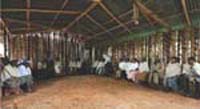10.1.1 Health talks
You may consider that the best way of communicating your health messages in certain situations is by using health talks. Talking is often the most natural way of communicating with people to share health knowledge and facts. In the part of your job that involves health education, there will always be many opportunities to talk with people.
Group size is also important. The number of people who you are able to engage in a health talk depends on the group size. However, you will find talks are most effective if conducted with small gatherings (5–10 people), because the larger the group the less chance that each person has to participate (Figure 10.2).

Think of some situations when you think it might be best to use health talks to get across your health education messages.
Talking is a very flexible form of communication. Talks can be conducted with one person, or with a family or a group of people, and you can adjust your message to fit the needs of that group. One example of this would be communicating a health message to a group of young mothers about their use of contraception. Even informal talks can include information about the benefits and side-effects of using contraception.
Talking to a person who has come for help is much like giving advice. But as you will see, advice is not the same as health education. To make a talk educational rather than just a chat you will find it beneficial if it is combined with other methods, especially visual aids, such as posters or audiovisual material. Also a talk can be tied into the local setting by the use of proverbs and local stories that carry a positive health message.
Preparing a talk
When you are preparing a talk there are many things to consider:
Detailed knowledge on these topics is covered in the Nutrition Module.
- Begin by getting to know the group. Find out its needs and interests and discover which groups are active in your locality.
- Then select an appropriate topic. The topic should be about a single issue or a simple topic. For example, although local people need help about nutrition, this is too big as a single topic to address in one session. So it should be broken down into simple topics such as breastfeeding, weaning foods, balanced diets, or the food needs of older people. Always ensure that you have correct and up-to-date information and look for sources of recent information. There may be leaflets available that can support your health messages.
- List the points you will talk about: Prepare only a few main points and make sure that you are clear about them.
- Next, write down what you will say: If you do not like writing, you must think carefully what to include in your talk. Think of examples, proverbs and local stories to emphasise your points and which include positive health messages
- Visual aids are a good way to capture people’s attention and make messages easer to understand. Think of what you have available to illustrate your talk. Well-chosen posters and photos that carry important health messages will help people to learn.
- Practice your talk beforehand: This should include rehearsing the telling of stories and the showing of posters and pictures.
- Determine the amount of time you need: The complete talk including showing all your visual aids should take not more than about 20 minutes. Allow another 15 minutes or more for questions and discussions. If the talk is too long people may lose interest.
Look again at the list of seven features of preparing a talk. Think about those areas in this list that you are confident about, and then those areas where you feel you will have to do some learning and practising.
The list shows the benefits of being well prepared. As you will see, only point 6 is actually about rehearsals! Most of the list is about being sure you know your audience and that you are well informed and know what you want to say and show. So, if you are nervous, then remember that you can cut down on anxiety by taking this list seriously and being very well prepared.
There are, of course other variations on talking. But all of them rely on the same key features, which are knowing your audience, being well prepared and practising.
10.1 Teaching methods
